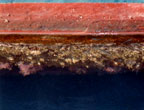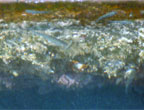SHIP FOULING. SHIP BOAT HULL CLEANING. Bottom cleaning.
Careen fouling is a special problem. In course of the ship operation, the hull fouling adversely impacts its hydro dynamic performance, thus resulting in its propulsive performance worsening. First of all, it results in the reductions of a ship's speed, achieving up to 50 % from nominal, worsening of maneuverability (low hydrodynamics), over expenditure of fuel, in connection with necessity to support commercially approved speed of the shipping, kingston fouling, intake adapting rings, heat exchangers and as a result, early wear out of machinery and equipment. It results in the docking frequency increase, and, of course, in the additional time and material losses being unreasonably high.
 |
 |
It is known that increase of the careen undulation for only 25 micrometers increases resistance for almost 2,5%, and the fouling with the shells and barnacles with the shell diameter 20-30mm, causes the drop in speed up to 4 knots and significant waste of fuel. Without hull cleaning, after a year of operation, a bulk-carrier having 2,500 tons in displacement, will drop the speed for approximately 25%, at that its operation cost will increase for more than 200,000 of USD due to the fuelling expenses increase.
Boat hull cleaning. By the fouling layer thickness comprising 2 to 3 cm, the weight of small shells per 1 sq.m. exceeds 50 kg, thus the ship being 150 m long and having the careen square of approximately 3 thousand square meters, gets more than 150 tons of additional bio mass weight. Even the marine propellers manufactured of special alloys, are prone to fouling. Over the course of one year of operation, a tanker having displacement 270,000 tons, travelling between the Latin America and Europe, drops from 17 to 14 knots of speed without hull cleaning. In order to maintain a ship's performance, the ship-owner is forced to increase the consumption of fuel and lubricating materials. Additional annual losses due to the forced engine running and increased fuel and lubricating materials demand achieve half a million USD.
Fuel economy is undoubtedly one of today's major reasons to keep the hull and its bottom clean. Fuel costs comprise for about a half of a ship’s operating costs. To compensate the decrease in speed, extra engine power is required, with a consequent increase in fuel consumption. It is obvious that a “smooth” hull is one of the main factors for the economical operation of a ship.
The newest CAVI-JET SYSTEMS allow conducting a rapid complex careen hull cleaning and bottom cleaning for the ships of any displacement on any stage of their operation, without docking in a dry or a floating dock. |